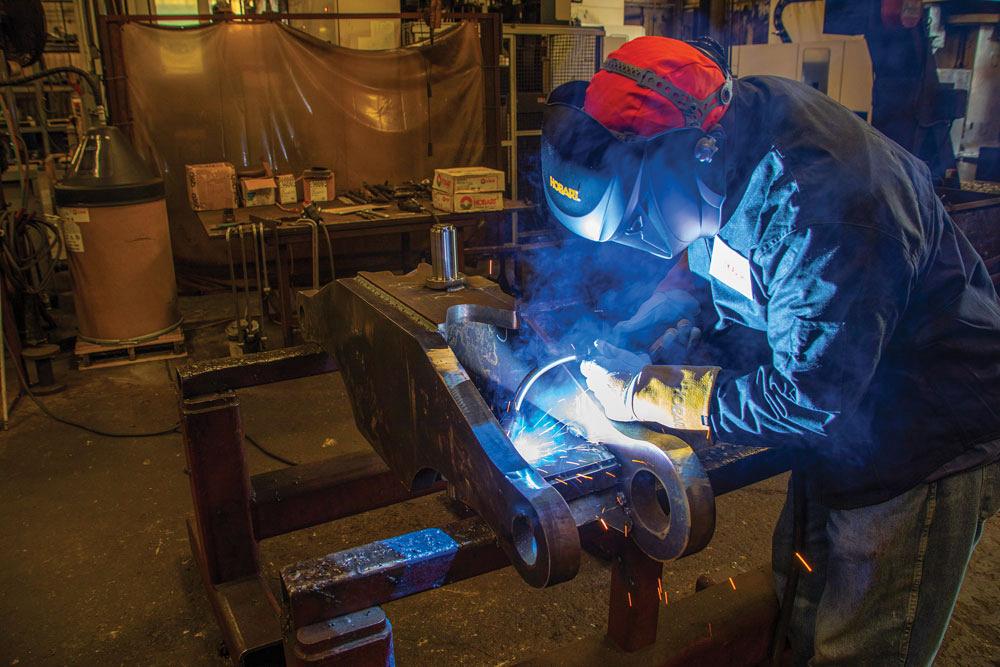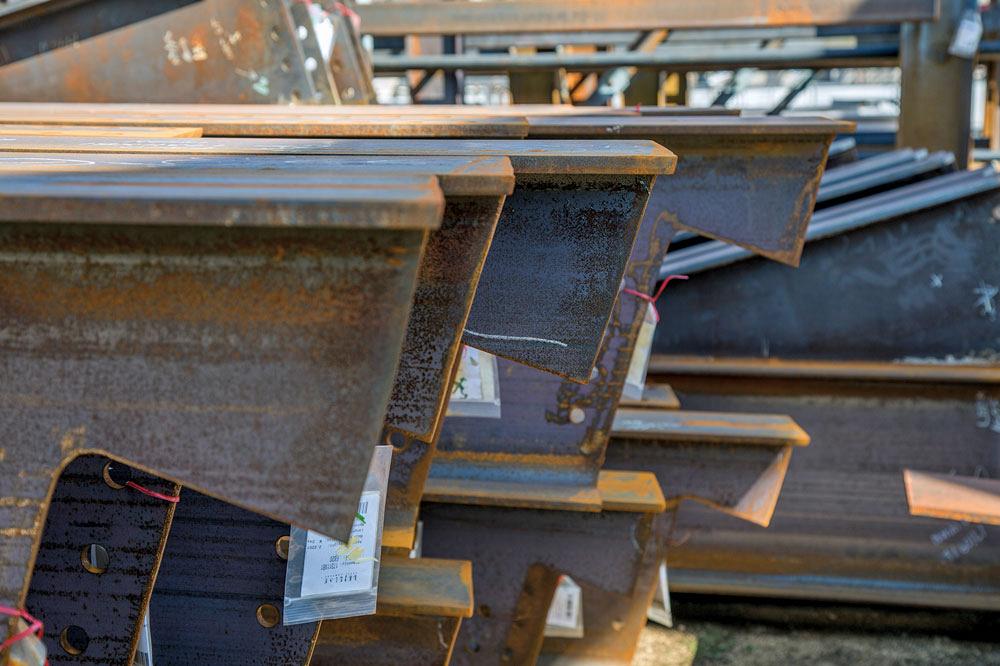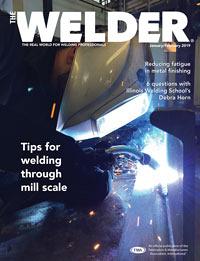Applications Welding Engineer
- FMA
- The Fabricator
- FABTECH
- Canadian Metalworking
Categories
- Additive Manufacturing
- Aluminum Welding
- Arc Welding
- Assembly and Joining
- Automation and Robotics
- Bending and Forming
- Consumables
- Cutting and Weld Prep
- Electric Vehicles
- En Español
- Finishing
- Hydroforming
- Laser Cutting
- Laser Welding
- Machining
- Manufacturing Software
- Materials Handling
- Metals/Materials
- Oxyfuel Cutting
- Plasma Cutting
- Power Tools
- Punching and Other Holemaking
- Roll Forming
- Safety
- Sawing
- Shearing
- Shop Management
- Testing and Measuring
- Tube and Pipe Fabrication
- Tube and Pipe Production
- Waterjet Cutting
Industry Directory
Webcasts
Podcasts
FAB 40
Advertise
Subscribe
Account Login
Search
How to weld through mill scale
Your welding process and consumables matter
- By Blaine Guy
- January 26, 2019
- Article
- Arc Welding
You have a few choices when it comes to tackling mill scale on steel parts. You can purchase cold-rolled steel, which due to the nature of the manufacturing process doesn’t have mill scale on its surface. This material, however, is more expensive and may not be in available the many thicknesses or dimensions you need.
Or you can purchase hot-rolled steel in the shotblasted condition (that is, with the mill scale removed), you can shotblast the plate yourself, or you can remove the mill scale manually in the welded areas by grinding during fabrication. These options all add cost.
One last option is to weld through the mill scale yourself, saving on time and money for precleaning and for the upfront cost of the material.
When choosing this option, you should be aware of the best practices to address the challenges of welding through mill scale, such as how to choose the right welding process, filler metal, and shielding gas for the job. The chosen parameters and technique also factor into your success.
What Is Mill Scale?
Before we talk about welding through it, it’s important to know exactly what mill scale is. The term hot-rolled steel comes from the manufacturing process. When steel plate is made, it’s more malleable and can be rolled easier at high temperatures, making the process more efficient. As the hot material encounters oxygen, an oxide layer—mill scale—forms on the surface.
The Problem With Mill Scale
During welding, mill scale hinders the flow of the liquid weld pool, often causing an undesirable weld appearance or contour. Mill scale also can impede penetration into the base material and cause a lack of fusion and weld inclusions. The greater the thickness or severity of the mill scale, the more challenges there are in welding the material.
You can avoid or minimize these challenges by reducing travel speed, but the trade-off is lower productivity and oftentimes an uptick in problems related to poor penetration.
Some welding processes, filler metals, and shielding gases are better-suited than others to overcome the difficulties of welding mill scale while still allowing for fast travel speeds and high productivity.
Use Gas-shielded Welding Processes on Mill Scale
If you weld in a fabrication shop or manufacturing environment, gas-shielded welding processes are a good choice.
When you’re welding through mill scale with a gas-shielded process, the options fall into a good, better, best scenario. These are, respectively, gas-shielded metal arc welding (GMAW) with solid wire, GMAW with metal-cored wire, and flux-cored arc welding (FCAW) with a gas-shielded wire.

Many welding operations choose to weld through mill scale on hot-rolled steel because it’s the most cost-effective option. Selecting the right welding process, filler metal, and shielding gas can help you overcome the difficulties of welding mill scale.
Solid Wire. The most common solid wires used for welding through mill scale are AWS ER70S-3 and ER70S-6. The main difference between the two is chemistry. The ER70S-6 wire has added deoxidizers to assist in breaking down mill scale during welding. An ER70S-6 wire also typically provides a better bead appearance and allows higher travel speed while still maintaining acceptable quality. When the steel has minor scaling on its surface and/or high travel speeds are not required, you can use solid wire with little trouble. Keep in mind that welding over mill scale with solid wire makes the arc susceptible to inconsistencies, producing spatter that requires postweld cleaning.
Metal-cored Wire. Metal-cored wires are a good option when the material has more mill scale or when improving productivity is a priority. Metal-cored wires are tubular and filled with metallic powders, alloys, and arc stabilizers, each offering distinct benefits for specific applications. These wires have more deoxidizers added that increase weldability on mill scale. In addition, metal-cored wires, in general, provide a more stable spray transfer and increased weld pool fluidity. These features allow for fast travel speeds, generate low spatter, and improve your ability to bridge gaps when compared to solid wires. The most common metal-cored wire for welding mild steel with mill scale is E70C-6M.
Flux-cored Gas-shielded Wire. The FCAW process is well-suited for welding through thick mill scale because of the high level of deoxidizers in the wire and the slag system it produces. The FCAW wires most used to weld mill scale are E71T-1 for welding in all positions and E70T-1 for welding in flat and horizontal positions only. It’s worth noting that wires for flat and horizontal welding typically outperform all-position wires in their ability to weld through mill scale.
While flux-cored wires are better for welding through mill scale, removing the slag does add cleanup time between weld passes, as well as postweld. In addition, flux-cored wires (and metal-cored wires) cost more than solid wires, so it’s important to weigh the filler metal costs against the labor and productivity savings offered.
In mild steel welding applications, 100 percent carbon dioxide (CO2) shielding gas or an argon/CO2 gas mixture is commonly used. Each offers advantages for welding through mill scale depending on the problems being addressed. Use a mixture with higher argon content if you struggle getting welds to wet out or lay down or struggle with spatter. If your welds typically suffer from a lack of fusion, lack of penetration, or weld inclusions, use a gas mixture with higher CO2 levels to achieve that additional penetration.
The Scoop on Self-shielded Welding
A gas-shielded process isn’t as feasible in welding applications that require more flexibility and mobility, such as those performed outdoors. In these situations you have two options: using self-shielded flux-cored welding (FCAW-S) or shielded metal arc welding (SMAW).
FCAW-S. These wires typically offer lower productivity than gas-shielded FCAW wires, but they can be used when hauling gas cylinders to the job site is not practical or if windy conditions create problems with maintaining shielding gas coverage. Self-shielded flux-cored wires also have a large amount of deoxidizers as well as a slag system that makes them well-suited for welding mill scale. Common self-shielded flux-cored wires for the job include E71T-8, E71T-11, E70T-6, and E70T-4.
SMAW. You can use SMAW, or stick welding, to weld through mill scale because the electrodes have deoxidizers and a slag system. Some stick electrodes are designed to offer better success when welding extremely thick scale or on very dirty base material. When you are welding moderate mill scale, any stick electrode is a good choice. Common AWS stick electrode classes are E6010, E6011, E6013, E7018, and E7024.
Considerations for Submerged Arc Welding (SAW)
The SAW process, which does not use a shielding gas, can be well-suited for welding through mill scale depending on the flux used.
SAW is a wire-fed process like GMAW and is used in manufacturing and fabrication operations, especially on large parts. Wire feeds through a torch that typically moves along the weld joint by mechanization. Unlike other welding processes, SAW relies on granular flux to protect the arc from the atmosphere. The arc is buried—submerged—in the flux and is not visible during normal operation. As the arc melts the wire, flux, and base material to form the weld pool, the molten flux performs important functions such as deoxidizing, alloying, shaping, and generating a protective atmosphere for the weld deposit.
SAW fluxes are neutral or active. Neutral fluxes don’t notably change the chemistry of the weld deposit and can produce acceptable results when welding over mill scale. They are better known for providing improved toughness over active fluxes. Active fluxes, by comparison, do very well welding through mill scale, offering good bead appearance and wetting action even at high travel speeds.
One downside to active fluxes is that their mechanical properties (specifically, toughness) often aren’t as good as those offered by neutral fluxes. Because active fluxes increase the alloy content of the weld and influence weld deposit chemistry, the number of weld passes that can be completed is limited. As more passes are made, an increasingly rich weld deposit chemistry results, which can cause problems. Active fluxes are best-suited for welding applications involving one to two passes.
About the Author
Blaine Guy
101 Trade Square East
Troy, OH 45373
937-332-4000
About the Publication
Related Companies
subscribe now

The Welder, formerly known as Practical Welding Today, is a showcase of the real people who make the products we use and work with every day. This magazine has served the welding community in North America well for more than 20 years.
start your free subscription- Stay connected from anywhere

Easily access valuable industry resources now with full access to the digital edition of The Fabricator.

Easily access valuable industry resources now with full access to the digital edition of The Welder.

Easily access valuable industry resources now with full access to the digital edition of The Tube and Pipe Journal.
- Podcasting
- Podcast:
- The Fabricator Podcast
- Published:
- 04/16/2024
- Running Time:
- 63:29
In this episode of The Fabricator Podcast, Caleb Chamberlain, co-founder and CEO of OSH Cut, discusses his company’s...
- Industry Events
16th Annual Safety Conference
- April 30 - May 1, 2024
- Elgin,
Pipe and Tube Conference
- May 21 - 22, 2024
- Omaha, NE
World-Class Roll Forming Workshop
- June 5 - 6, 2024
- Louisville, KY
Advanced Laser Application Workshop
- June 25 - 27, 2024
- Novi, MI

































